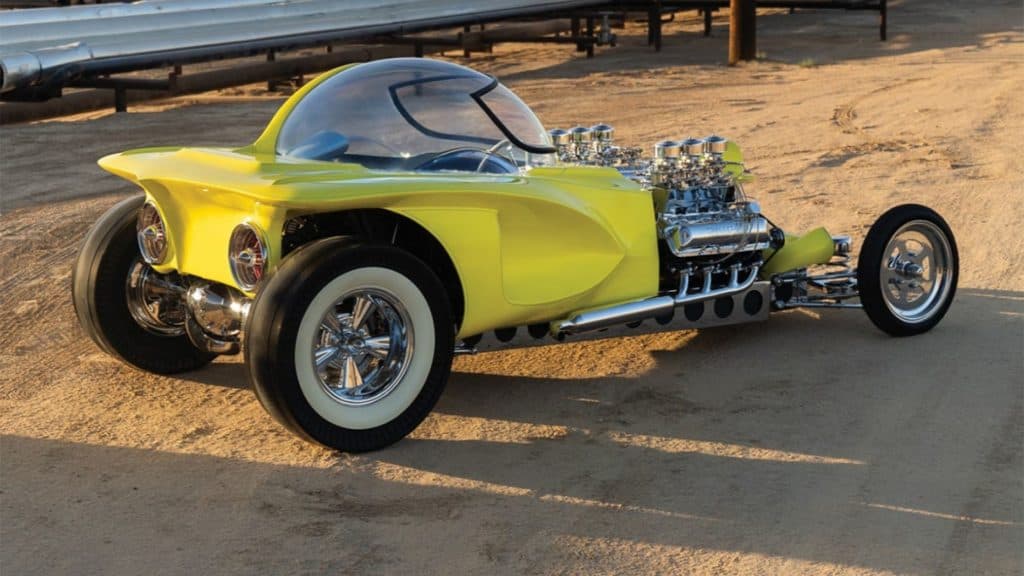
Ed Roth’s Mysterion is gone, but one superfan built his own — and now it’s up for auction…
RM Sotheby’s is offering the exceptional re-creation at its Petersen Automotive Museum Auction on December 8.
There is no reserve or pre-auction estimate, but the hot rod is expected to go for six figures.

Ed “Big Daddy” Roth
Always evolving, a ceaselessly changing grandmaster of self-promotion, Ed “Big Daddy” Roth was a highly creative artist with a sound grasp of mechanics and electrics.
He pioneered the use of new media like plaster of Paris, Vermiculite, and fiberglass to build his cars so he could pursue shapes and concepts far beyond anything other customizers had achieved.
More intrigued with producing rolling art statements than mechanical function, Roth nevertheless built bizarre vehicles that actually worked.
“New Journalism” founder, Tom Wolfe, author of The Bonfire of the Vanities and The Kandy-Colored, Tangerine-Flake Streamline Baby, called Ed Roth “the Salvador Dali of hot rodding.”

Ed Roth was a major player in mid-century Southern California car culture. He underpriced the big pinstriping and scallop painting names like Von Dutch, Dean Jeffries, and Larry Watson, and his business boomed.
Roth worked closely with artists like Joe Henning, Robert Williams, Ed “Newt” Newton, Tom Daniels, and Stanley Miller (a.k.a. Stanley Mouse).
Revell began to build what would eventually be millions of Roth model car kits. They were distributed around the world—and are still being re-issued.
Ed Roth’s imaginative cartoon characters, led by the irrepressible “Rat Fink,” a.k.a. “Mickey Mouse’s evil twin,” captivated worldwide audiences. Leave Ed to take the most popular children’s cartoon figure of the era and make it wicked, even vulgar.
The “weirdo” designs were just wild enough to annoy most parents, and impress kids, but still be on the right side of propriety. Roth discovered that if he built more crazy show cars, he would be invited to display them at major shows, often with expenses paid. Then he would be able to sell more T-shirts and other themed gear.

Over a tumultuous decade in the 1960s, Ed built a series of wild custom car creations that bore distant relationships to “conventional” hot rods and customs, but employed fresh new materials, fantastic shapes, wild colors, and modified engines to elevate the custom car genre to an artistic level never before achieved. Roth’s rods—a small number of one-offs—are unforgettable. Many survive in museums and private collections.
The first Roth car that attracted huge attention was, in the words of Robert Williams, “a futuristic space roadster” called the “Outlaw.” The “Beatnik Bandit” was next, a full-fendered, scallop-painted hot rod fantasy based on a rendering by Joe Henning. According to author and Roth biographer, Pat Ganahl, Roth told Henning he wanted something “far out.”
The “Mysterion,” a radical twin-engine car with a duo of 390-cu. in. Ford big-blocks, was probably inspired by two-engine dragsters like Tommy Ivo’s twin Buick. The engines are tilted and their natural offset permits exhaust header clearance. Although asymmetrical styling proved to be a short-lived fad, Ed had to try it.
The Mysterion had an oblong grille and odd-shaped nosepiece, with one large, pod-mounted headlight on the left and a smaller conventional light on the right. The hydraulically operated bubble top had a little windshield in the front. Larry Watson painted it gold Murano candy over the white pearl. Everything was chromed, including the chassis. However, the original Mysterion show car did not run.

After many appearances, Roth’s Mysterion was parted out and no longer exists. Jeff Jones, a widely published petroleum engineer and an admirer of Ed Roth, decided to build an exact functioning replica. There was virtually no documentation save for the Revell scale model and a few magazine articles.
Building the Mysterion Re-Creation
Jones built a new frame, sourced the correct Ford big-block engines, and mounted them so that one ran, and the other did not, but appears to be functional.
He faithfully copied the original Mysterion to the last detail. Jones then wrote a book, Ed Roth’s Mysterion, the Genesis, Demise, and Recreation of an Iconic Custom Car, detailing the extraordinary effort behind his bolt-by-bolt re-creation of the Mysterion.
This is a unique opportunity to acquire one of the most extraordinary custom car creations of the last century. Accurate in every detail, it is a running, drivable realization of Ed Roth’s most elaborate artistic vision.
Today, Ed Roth’s unique custom cars are held in esteem by hot rodders and artists. His creations are owned by the Petersen Automotive Museum, the National Automotive Museum in Reno, and noted Los Angeles collectors Bo Boeckmann of Galpin Auto Sports and Rick Rawlins, to name a few.
Individual Roth cars and objects d’art have been featured at The Contemporary Museum in Honolulu, the Laguna Beach Museum of Art, the Museum of Contemporary Art in Sydney, Australia, the San Jose Institute of Contemporary Art, the Huntington Beach Art Center, the Art Center School of Design, noted car Museums like the Petersen Automotive Museum and the Blackhawk Collection, and at the Amelia Island Concours, d’Elegance.




